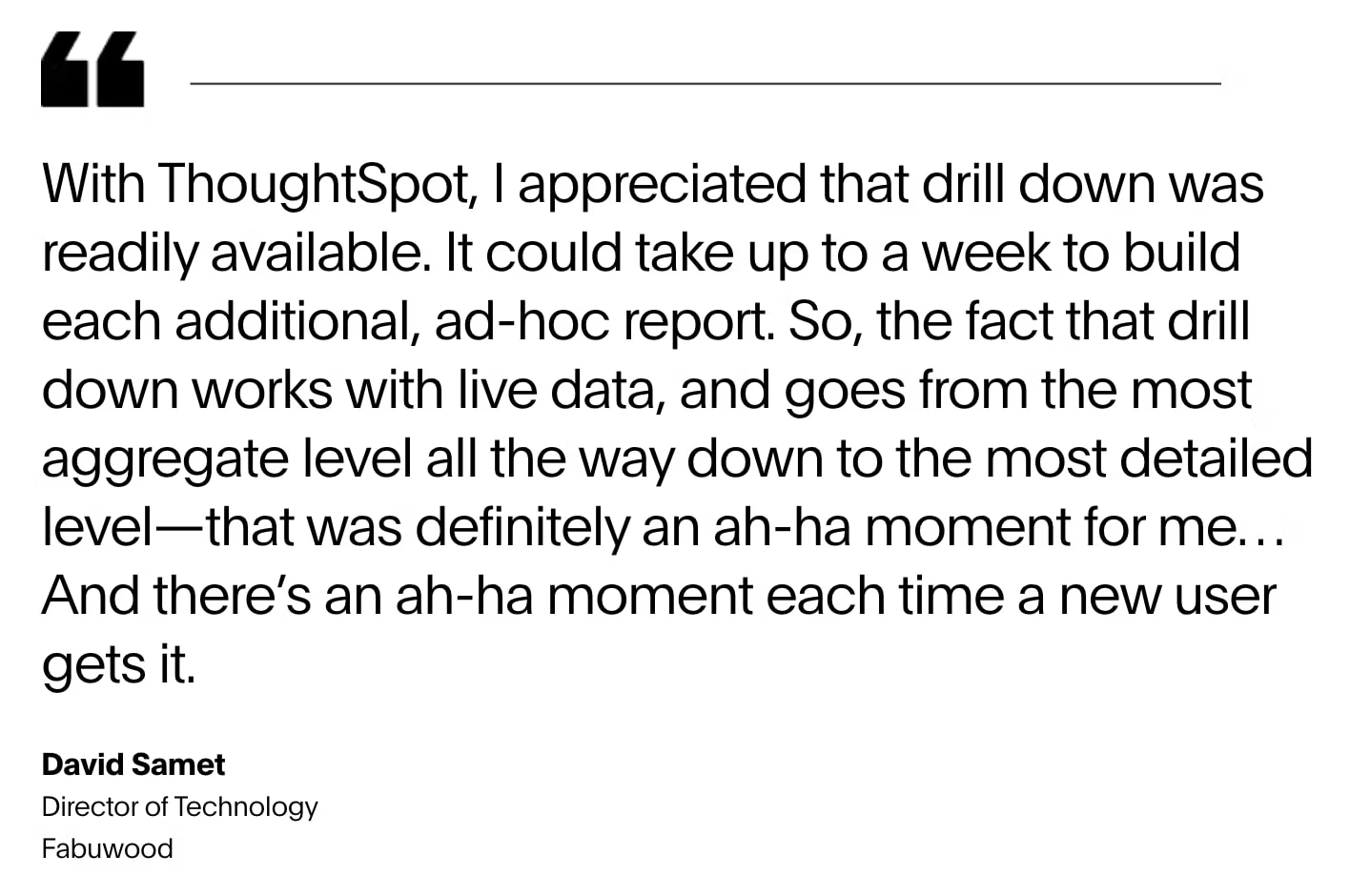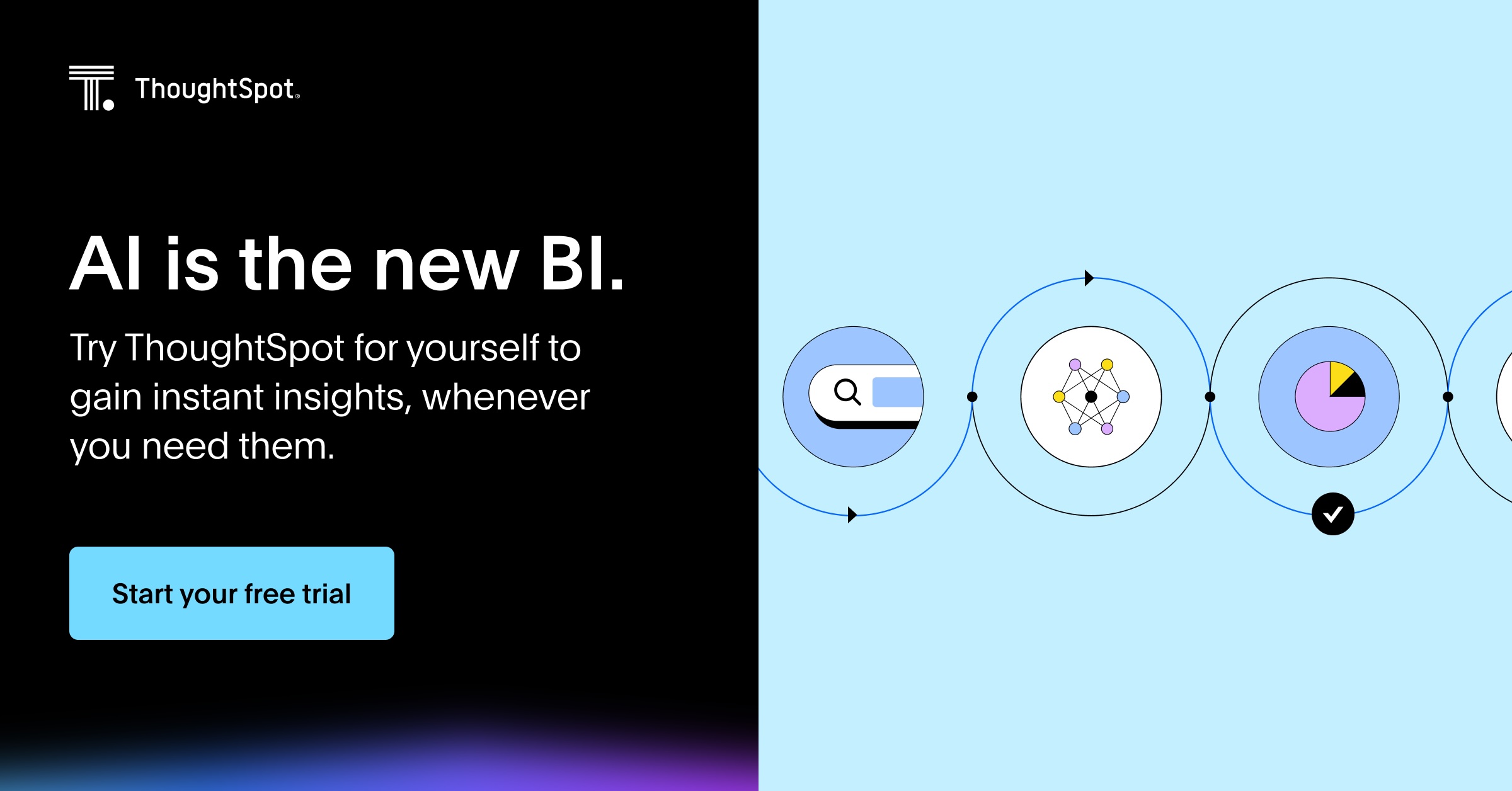According to a Mckinsey report, only a fraction of data from connected devices is processed, queried, and analyzed in real-time due to the limits of legacy tools and structures. This gap clearly highlights the disconnect between the promise of business analytics and the reality—where real-time data remains out of reach for most. Until now, that is.
Advances in AI are sparking a rebirth in the data and analytics industry, capturing global attention and triggering an explosion of creativity. Gone are the days when business users had to rely on data teams to create new dashboards and reports. With AI in business analytics, you are now the architect of your data journey. You are free to engage with your data, ask questions, drill into new data points, and create custom visualizations—and this is just one part of the story. Let’s take a look at the challenges of traditional business analytics and how AI in business analytics can help you unlock deeper insights from your data.
Table of contents:
While business analytics allow users to turn raw data into actionable insights, legacy data analytics tools often come with complicated interfaces that can take weeks to deliver even basic analyses. These outdated tools fail to deliver real-time, intuitive data experiences, leaving teams frustrated and hindered in their decision-making processes. Let’s explore these challenges in detail:
1. Data analysts are buried in operational tasks
Research shows that 92% of data workers spend most of their time on operational tasks outside the scope of their assigned roles. Because legacy business analytics tools demand extensive manual data processing and ongoing dashboard maintenance, data professionals have little bandwidth for focusing on strategic initiatives. Instead of freely exploring data, your team is overwhelmed by operational overhead. This lack of agility ultimately costs your business potential revenue and diminishes your competitive edge, preventing you from responding swiftly to market demands and customer needs.

2. Analytics remain descriptive, not predictive or prescriptive
In a recent episode of The Data Chief, Scott Stevens, Executive Director of Global Technology at JPMorgan Chase had this to say: “Business intelligence tends to have this notion of looking backwards. It's not thinking about prescriptive or predictive analytics, or live analytics.”
That’s because most traditional business analytics tools are built primarily to analyze historical data, providing answers to questions like "What happened last quarter?" or "How did our sales perform compared to last year?" While this retrospective analysis can be useful for understanding your current situation, it fails to address the dynamic needs of a modern business like yours. When you’re working with these tools, creating predictive models or forecasting trends seems almost like a futuristic fantasy.
3. Data experiences are static and generic
Imagine your data team creates a dashboard for your marketing team. While it certainly helps some leaders make informed decisions, not everyone will benefit from a generic marketing dashboard. For instance, the demand gen team might require a dashboard to track campaign performance, while the social media team may be more focused on engagement metrics and audience insights. Every team has different needs and requires interactive features to explore specific data points. Legacy business analytics with static dashboards and visualizations are too inflexible to offer real business value.
AI in data analytics is creating a paradigm shift in how both business users and data teams interact with a company’s data. By leveraging advanced machine learning (ML) algorithms and deep-learning models, AI is turning traditional analytics processes into more efficient and autonomous systems that deliver real-time, personalized insights in minutes. Here’s how today’s companies are using AI in business analytics to drive effective change across all fronts:
1. Self-service analytics for all business users
AI-powered business analytics tools are more attuned to users’ needs in terms of search, analysis, and visualization. What this really means is that these solutions allow users to quickly and easily access data, derive answers, and create reports on their own. Intuitive interfaces, paired with AI capabilities, empower even non-technical users to instantaneously spin up real-time visualizations and dashboards—without waiting for someone else to do it for them.
A great example is ThoughtSpot’s AI Analyst, Spotter. With Spotter, you can simply ask questions and receive instant insights and visualizations, making data exploration as simple as having a conversation. This innovative, intuitive approach not only democratizes access to data but also fosters a culture of self-service analytics across the organization.
2. Conversational, personalized data experiences
Forget basic dashboards and static reports. AI has brought us to a place where data experiences are as alive as our imagination. From asking follow-up questions to drilling down to the point of granularity, you can now explore various data dimensions, uncover hidden patterns, and gain deeper insights tailored to your specific needs.
Take, for instance, ThoughtSpot's AI-augmented dashboards. With these real-time Liveboards, you can gain contextual insights behind KPI changes that not only allow you to understand what has changed but also why it changed. Such actionable insights can significantly enhance decision-making, offering business stakeholders a clearer view of potential improvements and challenges.
3. Augmented analytics for forecasting outcomes
Previously, business analytics were primarily descriptive, providing insights solely about past events. However, as we embrace augmented intelligence, you can go beyond surface-level insights and leverage AI and ML to build predictive models that answer the question: ‘What important events are likely to happen next?'.
Further, modern data analytics solutions like ThoughtSpot can help you build prescriptive models and sentiment analysis models to easily anticipate outcomes and identify patterns and anomalies you would’ve otherwise missed. Here’s how ThoughtSpot makes it simpler for business users to forecast trends and explore different possibilities:
4. Automating tedious processes
AI in business analytics isn’t beneficial for only business users. It also liberates your data team from mundane data preparation tasks. With augmented data management, data teams can automate and streamline the entire process of data preparation and advanced reporting. These smart, adaptive systems identify relationships and mappings between data sets to create a unified data view of your operations. With such enhancements, data teams can focus on greater initiatives such as boosting ROI from different analytics programs or fostering a data-driven culture.
Modern data analytics solutions like ThoughtSpot offer data teams Analyst Studio wth powerful features such as AI-assisted data modeling with a notebook interface to reduce time-to-insight and promote data security across the organization.
AI in business analytics isn’t just for the data elite. It has multidisciplinary applications across a range of industries, helping users extract greater value from their data. Here are some examples.
1. Finance industry
With AI-powered business analytics, financial analysts can simulate different scenarios, project future outcomes, and assess the impacts of various decisions. And with interactive financial dashboards, you have real-time information right at your fingertips. Such insights can help you quickly identify trends, spot potential issues, and make informed decisions that ultimately boost your bottom line.
This was the case for Neobank Northmil. With ThoughtSpot’s AI-Powered Analytics, the company was able to identify precisely where customers dropped out during the onboarding process. These insights empowered Northmill to improve its onboarding process, boosting the conversion rates by a whopping 30%.
2. Retail industry
Retailers can use AI-powered business analytics to gain granular insights into the various stages of the sales and marketing process, from lead generation to deal closure. They can leverage real-time, interactive dashboards and AI-powered insights to identify high-performing sales regions, assess the impact of promotional strategies, recognize customer trends, and more.
Here’s a real-world example of how ThoughtSpot’s interactive retail Liveboards empowered the data team of luxury kitchen manufacturer Fabuwood to gain greater visibility into their sales operations:

3. Telecom industry
By pulling customer data from various touchpoints, AI-powered business analytics can help telecom companies gain valuable insights into customer preferences, behaviors, and pain points. This data-driven understanding can help you personalize service offerings, recommend relevant products or promotions, and provide targeted support tailored to individual customer needs. For instance, by analyzing data utilization patterns and identifying peak usage times, telecom providers can spot opportunities for upselling complementary services such as streaming packages or data add-ons.
There’s never a shortage of business problems. Every day you have to tackle several challenges such as streamlining operations, understanding new marketing trends, crafting new customer experiences, and so much more. Relying on legacy business analytics tools simply won’t cut it.
With AI in the picture, you can now create your own destiny. Harnessing the power of language learning models and GenAI, ThoughtSpot empowers every user in your organization to analyze, explore, and share insights however they want. With interactive Liveboards and augmented analytics features, your team can uncover insights in mere minutes.
See how AI-Powered Analytics can create tangible value for your business—schedule a ThoughtSpot demo.









